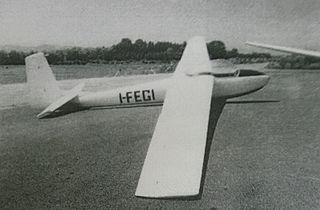Related Research Articles
The CVV1 Pinguino was a single seat, high performance glider designed and built in Italy in the mid-1930s, the first of a series of gliders from the Milan Polytechnic. It did not go into production.
The CVV 2 Asiago is a simple, single seat glider designed and built in Italy in the mid-1930s, the second of a series of gliders from the Milan Polytechnic and the first go into production.
The CVV 7 Pinocchio was a single seat competition glider designed and built in Italy, first flown in 1952 though designed in 1940. Only one was built.

The CVV 8 Bonaventura was a two-seat competition glider designed and built in Italy during the 1950s. Fifteen were produced.
The Aeronautica Lombarda AL-3 was an Italian sailplane, designed and built in 1939 to take part in the Olympic sailplane competition. It did so but was not successful.
The Bonomi BS.4 Basettino was a primary glider designed and built in Italy in the 1930s.

The Bonomi BS.7 Allievo Italia was a single seat, primary glider designed and built in Italy in the 1920s.

The Bonomi BS.17 Allievo Cantù was a single seat training glider, designed and built in Italy in 1934 and widely used by flying clubs.
The Bonomi BS.18 Airone was a single seat training glider, designed in Italy in 1936. Only one was built.
The Bonomi BS.28 Alcione, sometimes known as the Lombarda BS.28 Alcione, was a single seat competition sailplane designed and built in Italy in 1937-8. About four were completed, with two more or less refined fuselages.
The Aviomilano CPV1, also known as the Arlecchino, was an Italian high performance sailplane built in the early 1960s. Only one was built.

The Rotondi R.2 Tobia was built as a student group project in an Italian technical institute, begun in 1958. The sole example of this single seat, wooden glider first flew in 1962.
The Tedeschi E.T.186 was a simple, single seat training glider built in Italy and first flown in 1947. Only one was constructed.
The DTGL Sant' Ambrogio was an Italian single seat glider, designed and built by a 19-year-old model aircraft enthusiast, that competed in the 1938 national championships. Four more were constructed from his plans.
The Sala N1 or N1 Sala was a single-seat,18 m span competition glider built in Italy in 1933. Only one was constructed.
The GVV Dal Molin Roma or Mori Anfibio Roma was a single-seat, amphibious flying boat glider built in Italy in 1933. Only one was constructed.
The GP1 was an Italian glider constructed by university students in Pavia in 1925. Only one was built.
The Teichfuss Gabbiano was an Italian, one-off, single seat, high performance glider, designed by Luigi Teichfuss and flown in 1928.
The Teichfuss Grifo was an Italian training glider designed by Luigi Teichfuss and flown in 1934. It was built in small numbers.
The Teichfuss Astore was an Italian Intermediate single-seat trainer glider designed by Luigi Teichfuss and flown in 1936. Two were built.
References
- ↑ Grey, C.G. (1972). Jane's All the World's Aircraft 1938. London: David & Charles. p. 187c. ISBN 0715-35734-4.
- 1 2 3 4 5 6 Pedrielli, Vincenzo; Camastra, Francesco (2011). Italian Vintage Sailplanes. Königswinter: EQIP Werbung & Verlag GmbH. pp. 182–3. ISBN 9783980883894.
- 1 2 "Le Romeo Ro-35 à longeron "Monospar"". Les Ailes (583): 13. 18 August 1932.